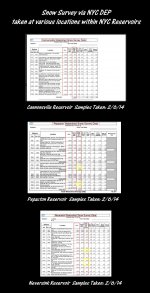TR
"You can observe a lot just by watching." Y. Berra
Good morning.
Attached is a NYC DEP snow survey which is compiled every three weeks for locations around the New York City reservoirs in the Catskills and Delaware River system.
The last survey was taken on February 6th prior to two storm events (2/13 and 2/15) that will have added anywhere from 18 to 24+ inches to the data.
As you can see there are areas in the Neversink and Pepacton drainage at high elevations of close to 2000 feet - say, near Frost Valley / Denning / Slide Mountain that had 17 inches prior to this week so it's conceivable that many areas will have in excess of 35 to 40 inches of snow when the next snow is recorded at the end of this month.
How does this compare to last year - 2013?
We have almost 2 to 2.5X the snowpack.at the current time versus NYC DEP snowpack studies for mid February with possibly 4 to 6 more weeks of winter and maybe two or three more storms. Plus - the river and shoreline did not have the amount of ice that we have at present which will dilute the river as it thaws keeping it colder and higher.
How does this compare to 2012?
There was virtually no snowpack in late February and the hatches that I recorded were a month early with Hendricksons beginning in late March and the Main Stem water temps I have recorded were on 4/20/12:
58 to 64 degrees at 3.2 near Long Eddy. The Hendrickson showed from late March to early April and by the middle of April the caddis were finished.
Tight lines,
TR

Attached is a NYC DEP snow survey which is compiled every three weeks for locations around the New York City reservoirs in the Catskills and Delaware River system.
The last survey was taken on February 6th prior to two storm events (2/13 and 2/15) that will have added anywhere from 18 to 24+ inches to the data.
As you can see there are areas in the Neversink and Pepacton drainage at high elevations of close to 2000 feet - say, near Frost Valley / Denning / Slide Mountain that had 17 inches prior to this week so it's conceivable that many areas will have in excess of 35 to 40 inches of snow when the next snow is recorded at the end of this month.
How does this compare to last year - 2013?
We have almost 2 to 2.5X the snowpack.at the current time versus NYC DEP snowpack studies for mid February with possibly 4 to 6 more weeks of winter and maybe two or three more storms. Plus - the river and shoreline did not have the amount of ice that we have at present which will dilute the river as it thaws keeping it colder and higher.
How does this compare to 2012?
There was virtually no snowpack in late February and the hatches that I recorded were a month early with Hendricksons beginning in late March and the Main Stem water temps I have recorded were on 4/20/12:
58 to 64 degrees at 3.2 near Long Eddy. The Hendrickson showed from late March to early April and by the middle of April the caddis were finished.
Tight lines,
TR

